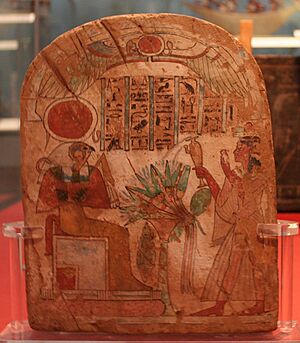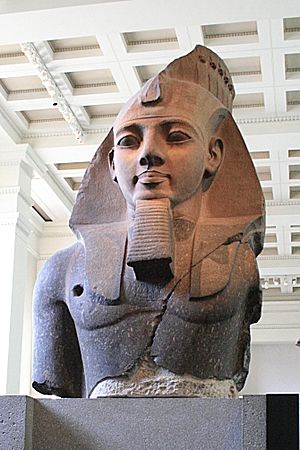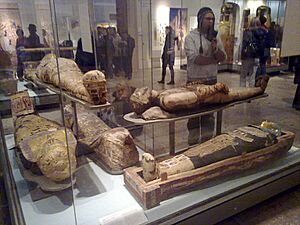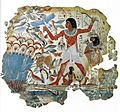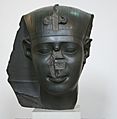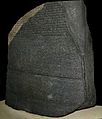British Museum Department of Ancient Egypt and Sudan facts for kids
The Department of Ancient Egypt is a super important part of the British Museum. It has over 100,000 amazing items from ancient Egypt! This makes it the biggest collection of Egyptian treasures anywhere outside of the Egyptian Museum in Cairo, Egypt.
How the Collection Started
Early Days of the Museum
The British Museum started collecting Egyptian items way back in 1753. They received 160 objects from a man named Sir Hans Sloane. This was just the beginning of their incredible collection.
Napoleon and New Treasures
A big boost came in 1803. After the British army defeated Napoleon's French forces in Egypt, many Egyptian treasures were taken. These items, including the famous Rosetta Stone, were given to the British Museum. This was the first time the museum got so many large and important sculptures.
Growing the Collection with Explorers
Later, a British consul in Egypt named Henry Salt gathered a huge collection. He worked with a famous Italian explorer, Giovanni Belzoni, who was very clever at moving these ancient objects. Most of Salt's collection was bought by the British Museum and the Musée du Louvre in Paris.
Discoveries from Digs
By 1866, the museum had about 10,000 Egyptian objects. More items arrived from archaeological digs in the late 1800s. The Egypt Exploration Society brought over 11,000 objects. These included finds from places like Amarna and Deir el-Bahari. Other groups and people, like Flinders Petrie, also donated items.
Modern Excavations and Gifts
The museum kept supporting digs in Egypt throughout the 1900s. This brought in many important new pieces. Even though rules about exporting finds from Egypt changed, the museum still got items from Sudan. The British Museum also did its own digs in places like Asyut and Ashmunein. Today, the Egyptian collection has more than 110,000 objects!
In 2001, the museum added six million more objects! These came from Professor Fred Wendorf of Southern Methodist University. They were all the items and environmental remains from his digs in the Sahara Desert between 1963 and 1997. These finds help us understand Prehistoric Egypt and Sudan.
What You Can See Today
The British Museum has seven permanent galleries dedicated to ancient Egypt. These galleries can only show about 4% of the museum's huge Egyptian collection. The second floor has a selection of 140 mummies and coffins. This is the largest collection of mummies outside of Cairo. Many items come from tombs or are linked to beliefs about death. These pieces, especially the mummies, are very popular with visitors.
Amazing Egyptian Collections
Here are some of the most important items in the collection, organized by time period:
Predynastic and Early Dynastic Period (c. 6000 BC – c. 2690 BC)
This was a very early time in Egypt's history, before the great pyramids.
- Mummy of Ginger from Gebelein (around 3400 BC)
- Flint knife with an ivory handle, called the Pit-Rivers Knife (around 3100 BC)
- The Battlefield Palette and Hunters Palette, which are decorated cosmetic palettes (around 3100 BC)
- Small ivory statue of a king from Abydos (around 3000 BC)
- King Den's sandal label from Abydos (around 2985 BC)
- Stone slab (stela) of King Peribsen (around 2720–2710 BC)
Old Kingdom (2690–2181 BC)
This was the time of the great pyramid builders.
- Items from the tomb of King Khasekhemwy (2690 BC)
- Granite statue of Ankhwa, a shipbuilder (around 2650 BC)
- Original casing stones from the Great Pyramid of Giza (around 2570 BC)
- Statue of Nenkheftka from Dishasha (2500 BC)
- Limestone false door of Ptahshepses (2380 BC)
- Wooden tomb statue of Tjeti (around 2345–2181 BC)
Middle Kingdom (2134–1690 BC)
A period of stability and great art.
- Inner and outer coffin of Sebekhetepi (around 2125–1795 BC)
- Limestone stela of Heqaib from Abydos (1990–1750 BC)
- Quartzite statue of Ankhrekhu (1985–1795 BC)
- Granite statue of Senwosret III (1850 BC)
- Block statue and stela of Sahathor (around 1922–1878 BC)
- Limestone statue and stelae from Inyotef's chapel (around 1920 BC)
New Kingdom (1549–1069 BC)
The time of powerful pharaohs like Ramses II and Tutankhamun.
- Schist head of Pharaoh Hatshepsut or Tuthmosis III (1480 BC)
- Piece of the beard from the Great Sphinx of Giza (14th century BC)
- Giant head from a statue of Amenhotep III (1350 BC)
- Large limestone bust of Amenhotep III (1350 BC)
- Amarna Tablets, 99 clay tablets that tell us about ancient diplomacy (1350 BC)
- List of the kings of Egypt from the Temple of Ramesses II (1250 BC)
Third Intermediate Period (1069–664 BC)
A time when Egypt was divided.
- Statue of the Nile god Hapi (around 900 BC)
- Mummy case and coffin of Nesperennub (around 800 BC)
- Shabaka Stone from Memphis (around 700 BC)
- Statue of Amun protecting King Taharqa (683 BC)
- Inner and outer coffins of the priest Hor (around 680 BC)
- Granite statue of the Sphinx of Taharqo (680 BC)
Late Period (664–332 BC)
Egypt was often ruled by foreign powers during this time.
- Sarcophagus of Sasobek, a prime minister (664–610 BC)
- Bronze figure of Isis and Horus (600 BC)
- Sarcophagus of Hapmen (600–300 BC)
- Kneeling statue of Wahibre (530 BC)
- Sarcophagus of Ankhnesneferibre (525 BC)
- Obelisks and sarcophagus of Pharaoh Nectanebo II (360–343 BC)
Ptolemaic Dynasty (305–30 BC)
This was when Greek rulers, like Cleopatra, ruled Egypt.
- The famous Rosetta Stone, which helped us understand hieroglyphs (196 BC)
- Giant sculpture of a scarab beetle (32–30 BC)
- Piece of a statue of Ptolemy I Soter (305–283 BC)
- Mummy of Hornedjitef (inner coffin) (3rd century BC)
- Wall from a chapel of Queen Shanakdakhete (around 150 BC)
- Naos of Ptolemy VII (around 150 BC)
Roman Period (30 BC-641 AD)
Egypt became part of the Roman Empire.
- Schist head of a young man from Alexandria (after 30 BC)
- The Meriotic Hamadab Stela from Sudan (24 BC)
- Lid of the coffin of Soter and Cleopatra (early 2nd century AD)
- Mummy of a youth with a portrait (100–200 AD)
- Bronze lamp and patera from X-group tombs (1st–6th centuries AD)
- Coptic wall painting of saints (6th century AD)
Gallery
-
Room 4 – Three black granite statues of the pharaoh Senusret III, c. 1850 BC
-
Room 68 - Part of the el-Amarna hoard, Egypt, c. 1850-1800 BC (18th dynasty)
-
Room 4 – Three black granite statues of the goddess Sakhmet, c. 1400 BC
-
Room 4 – The Rosetta Stone, key to the decipherment of Egyptian hieroglyphs, 196 BC
-
Room 62 - Detail from the mummy case of Artemidorus the Younger, a Greek who had settled in Thebes, Egypt, during Roman times, 100-200 AD


